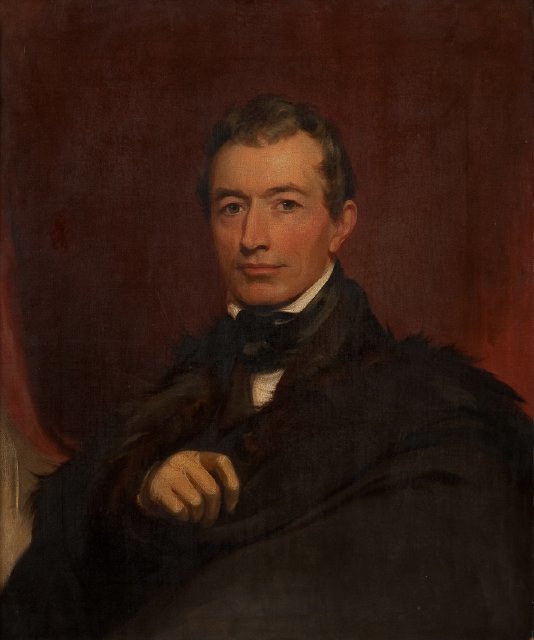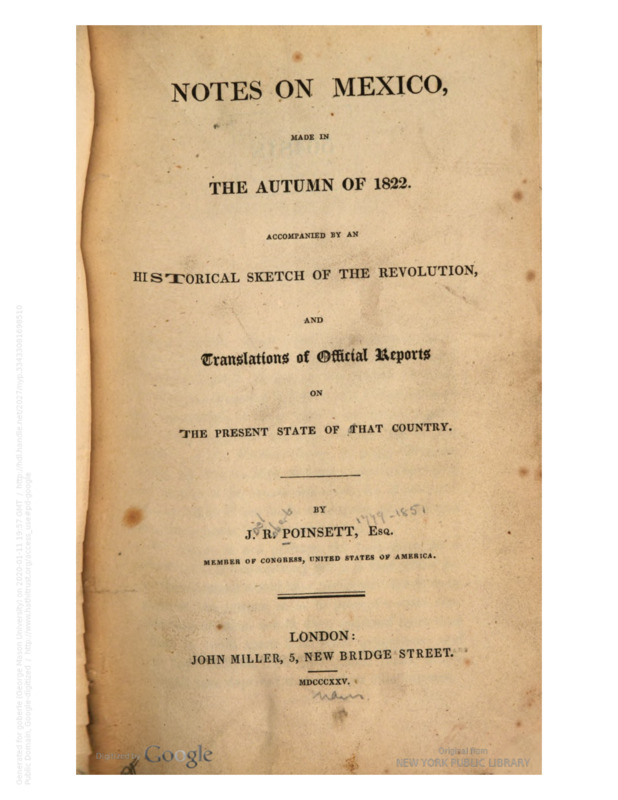Joel Poinsett
Joel Roberts Poinsett exemplifies the collector that served on diplomatic missions. In 1801, when Poinsett was 22, he began his grand tour across Europe.[1] His journeys across Europe and into Russia during the Napoleonic Wars stimulated his desire to acquire profitable specimens of seeds and other useful knowledge for the United States. Poinsett’s report on South America in 1818 focused on the political and social organization in South American regions such as Argentina, Paraguay, Chile, and Peru. This experience provided Poinsett with the skills sought after by American leaders in government and learned societies. The diplomatic presence which men like Poinsett provided offered access to the resources and knowledge within regions they visited. This access allowed them to share that knowledge in several ways which encouraged building a national identity.
His Notes on Mexico demonstrate Poinsett’s keen eye for descriptive detail of the environment and its natural resources. He made careful use of other accounts of Mexico, especially Humboldt’s, whose work Poinsett mentioned frequently. Poinsett even stated that he was so impressed with the description of Humboldt’s “researches” that he became “disposed to abandon my journal” since “he has seen more of the country and described it better than any other can hope to.”[2] Poinsett continued to describe the environment nonetheless and in particular, his activities. He made special notes of plants, trees, and architectural elements as well as sites of antiquity, including the ancient pyramids and their contents. For example, while exploring a “square cavity discovered in the interior of the pyramid…there were two skeletons, idols in basalt, and some vases curiously painted and varnished.”[3] While in Mexico City he described an excavation under the cathedral in the “great square” which “stands on the ruins of “the great teocalli or temple of the God Mixitli.” There after “digging twenty or thirty feet deep…a number of idols and other remains of Azteck sculpture were discovered among them them were a large stone containing the Mexican calendar, a colossal statue of the goddess Teoyaomiqui, and this stone is generally called the altar of sacrifice.”[4] Interestingly, these items were unearthed several years before and then reburied and dug up to show Alexander von Humboldt during his 1803 trip and then reburied. They were finally dug up in 1823 so that William Bullock could make a cast for his famous exhibition titled Ancient Mexico in the Egyptian Hall in London. Poinsett’s Notes was well received in the press and widely reported across the republic and even published in London by 1825.
Notes
[1] Versatile American
[2] Joel Roberts Poinsett, Notes on Mexico, Made in the Autumn of 1822. (London: John Miller, 1825), 59.
[2] Joel Roberts Poinsett, Notes on Mexico, Made in the Autumn of 1822. (London: John Miller, 1825), 58.
[3] Joel Roberts Poinsett, Notes on Mexico, Made in the Autumn of 1822. (London: John Miller, 1825), 74. Interestingly these items were unearthed several years before and then reburied and dug up to show Alexander von Humboldt during his 1803 trip and then reburied. They were finally dug up in 1823 so that William Bullock could make a cast for his exhibition titled Ancient Mexico in the Egyptian Hall in London.

